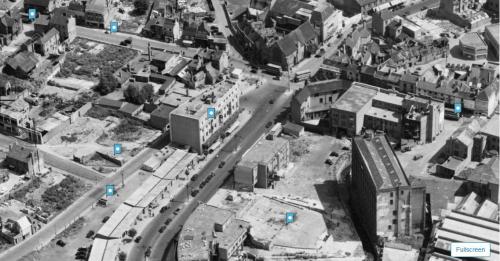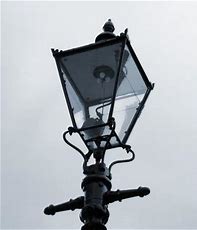
|
Annewiggy
Tamworth |
46 of 57
Wed 15th Apr 2020 4:17pm
This shot from Britain from Above is 1946. The stands are still there on the islands but you can't see if they are complete. Is it possible that they were replaced with electric after the war using the same stands?

|
| Local History and Heritage - Gas street lighting in Coventry | |
|
Slim
Another Coventry kid |
47 of 57
Wed 15th Apr 2020 9:53pm
Having read previous posts, and studied the photo carefully (blowing it up as much as possible), I'm fairly certain of a couple of things. First, I'm sure the shot was staged, because the "workman" does look too smart, as if he's in a marching band, not overalls. He's bolt upright - normally your body would be bent over the job in hand. He doesn't appear to have any tools or accessories, not even a cleaning cloth or a bottle of cleaner. And he appears to be merely touching the lamp lightly, as if posing.
Secondly, they're not gas. As Rob says, they're on chains. No sign of a gas pipe, which would most likely be thicker than an electric flexible cord. And if gas, it would have to be a flexible hose, not a solid pipe, which would be even thicker, since the fitting is on a chain which will swing . From what I can see, the glass fitting doesn't appear to house a gas mantle, more like a clear lamp; maybe incandescent (tungsten filament), or possibly discharge, mercury-vapour, which was common in street lights for many decades, with its characteristic bluish glow. (They preceded the sodium lamp, with its horrible monochromatic yellowy-orange glow.)
If you look at other photos of the gas lamps, like the ones we had in our road when I was knee-high to a grasshopper, the glass part was larger, to allow fumes and heat to dissipate. There was more gas-associated gubbins inside than can be seen in this photo. But in all the gas lamps I've come across, the glass and the works were fixed, i.e. could not flap about. It must be borne in mind that gas mantles are/were extremely delicate and easily damaged things. In our picture, the whole of the light fitting, hanging from a chain, would be swinging around in the breeze or wind, and you wouldn't want that if it were a gas lamp, would you? |
| Local History and Heritage - Gas street lighting in Coventry | |
|
Slim
Another Coventry kid |
48 of 57
Wed 15th Apr 2020 10:18pm
A typical Coventry gas street lamp:
 See what I mean - it's solid, so won't swing in the wind, which would at best unstabilise the flame. And there's all the gubbins, the mantle/burner, igniter, timing clock etc.
Also, note that the glass enclosure is completely open at the bottom, to allow fresh air in, with controlled ventilation at the top to allow the fumes to escape by convection. In the Corporation Street photo, the round glass bowl appears to be sealed at the bottom, which means that the gas could never burn (without a separate oxygen supply).
I rest my case.
See what I mean - it's solid, so won't swing in the wind, which would at best unstabilise the flame. And there's all the gubbins, the mantle/burner, igniter, timing clock etc.
Also, note that the glass enclosure is completely open at the bottom, to allow fresh air in, with controlled ventilation at the top to allow the fumes to escape by convection. In the Corporation Street photo, the round glass bowl appears to be sealed at the bottom, which means that the gas could never burn (without a separate oxygen supply).
I rest my case.
|
| Local History and Heritage - Gas street lighting in Coventry | |
|
mcsporran
Coventry & Cebu |
49 of 57
Thu 16th Apr 2020 12:11am
It seems to me that this is more likely to be a publicity shot for the conversion to electricity. Even the vehicle looks like a milk float, no radiator, battery powered. |
| Local History and Heritage - Gas street lighting in Coventry | |
|
Dreamtime
Perth Western Australia |
50 of 57
Thu 16th Apr 2020 2:52am
I remember saying it was a 'set up', so obvious. |
| Local History and Heritage - Gas street lighting in Coventry | |
|
Annewiggy
Tamworth |
51 of 57
Thu 16th Apr 2020 10:49am
Just another date to throw into the pot. The "City of Coventry Gas Department" on the side of the truck passed from the control of the city on the evening of 30th September 1949. It then became a unit of the nationalised gas industry. Would they have continued using the Coventry truck or does this mean the picture was pre 1949? I wonder also if the gas lights were not working after the war they would have been converted before 1949. |
| Local History and Heritage - Gas street lighting in Coventry | |
|
Annewiggy
Tamworth |
52 of 57
Thu 16th Apr 2020 11:11am
I am even more confused now. There is a picture "Coventry memories" taken from behind one of the arms of the lamps in the truck picture dated 1939!
|
| Local History and Heritage - Gas street lighting in Coventry | |
|
20A-Manor House
Coventry |
53 of 57
Thu 16th Apr 2020 12:01pm
Wow! I can't help with the date or why it was taken. But so many great posts about the picture. |
| Local History and Heritage - Gas street lighting in Coventry | |
|
Helen F
Warrington |
54 of 57
Thu 16th Apr 2020 12:52pm
So I've checked Britain From Above and the buildings on the north side of Well Street were there in 1939 but not 1946. They were 'modern' brick buildings of substantial size and unlikely to have been demolished before the war. So it's likely that the photo was post war and the buildings were destroyed in the bombing. The gas building itself looks a bit worse for wear as if time and bomb damage has taken the newness off. |
| Local History and Heritage - Gas street lighting in Coventry | |
|
Kaga simpson
Peacehaven, East Sussex |
55 of 57
Sat 18th Apr 2020 1:01pm
Chapelfields was known as 'the land' when first laid out. One of the most pleasing of the city. A painted view from Hearsal-hill of full view of the town the elevated spot 340 ft above sea-level as seen on a foggy night bears resemblance to a seaside town with lights as if seen from the sea, the gas lamps from Hertford street seen as a pier. |
| Local History and Heritage - Gas street lighting in Coventry | |
|
PeterB
Mount Nod |
56 of 57
Sat 18th Apr 2020 5:34pm
There is a 1957 photo of the Co-op which seems to show the original lamp column with a new top with fluorescent lights.
Peter. |
| Local History and Heritage - Gas street lighting in Coventry | |
|
Kaga simpson
Peacehaven, East Sussex |
57 of 57
Sun 19th Apr 2020 10:45am
Neil has a photo of the same gas lamp before the war on the Corporation Street topic. |
| Local History and Heritage - Gas street lighting in Coventry | |
Website & counter by Rob Orland © 2024
Load time: 597ms